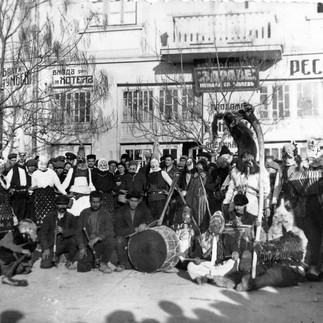Costume of the "first chaush", the leader of the neighborhood in the ritual Starchevata in Razlog
- Елица Парапунова
- Jul 15, 2021
- 2 min read
Updated: Nov 2, 2021
“Starcheva” is celebrated annually on January 1. There is no exact year for the beginning of the festival, but it is certain that it has been celebrated for more than a century. In the past, the holiday began on the evening before the first day of the new year with the custom "Survakane". The children decorated the dogwood twig, and the mother had to sew the “survakar bag” and to decorate it with “aspri”, fringes and “pusheta”. All night the children went around the houses and were donated with cakes, coins, fruits and nuts. Preparations for the holiday, however, began months earlier. People bought and rented bells and “tumbeltsi” from different parts of Bulgaria. The mummer's costume was made of goatskin or sheepskin, and they wore a “spout” on their head, which was several meters high and extremely heavy. Today, leather processing takes even more time. In November, the participants in the carnival go around their neighborhood and collect money and wood, selling the wood and paying the orchestra with the funds and covering the other expenses. Each neighborhood has a specific date on which it makes a dress rehearsal, in which both old and young participate, called "nakachvane".

The first “chaush” is the leader of each neighborhood, who plays the role of a guard. He must be a young man, unmarried, with more experience than the others, and has not yet gone to the barracks. When they have equal experience it is measured with a stick and hands , and which is on the top, he will be the first “chaush”. Everyone follows his steps and actions.

The furs are made of leather on a stick, and the processing and manufacturing itself takes two or three months, and sometimes even more. The first “chaush” should have the biggest four bells on the cross and carry a ponytail in hand. His “chuchulka”, which is a tall pointed hat made of leather, must also be the highest, because it is believed that the chaush is the mediator between earth and sky. His dressing is a whole ritual. If necessary, only the second chaush can replace the first.


The costumes of the chaushi and their bells are owned by families from Razlog.
The old photos are from the fund of the Historical museum in Razlog.
The project "Study of the specifics and richness of national costumes from the Razlog region in the light of cultural diversity" is realized with the financial support of the National Culture Fund under the program "Cultural Heritage".
In fulfillment of the goals of the project we present some of the most beautiful traditional costumes, typical for the Razlog valley in the last 2 centuries.
We offer our sincere thanks to our hosts from the Historical Museum - Razlog, and to all local people who helped with the realization.
Special thanks to all participants and team members who took their time and with useful information, knowledge and valuable advice made possible the work on the project.
A reverence to the girls and boys from the town of Razlog, who stood in front of our camera and with their enthusiasm, youth and beauty revived for a new life the most beautiful costumes from old Mehomiya.













Comments